|
|
|
Sort Order |
|
|
|
Items / Page
|
|
|
|
|
|
|
| Srl | Item |
| 1 |
ID:
190866


|
|
|
|
|
| Summary/Abstract |
The aim of this article is to add an air power perspective to the innovation field, with emphasis on the development of jet fighters. Contemporary theory has not adequately addressed air power-related significant innovation, a shortcoming this article addresses. Using in-depth qualitive research methodology with eight diverse case-studies in the Cold War period, we show that innovation of jet fighters was typically initiated in response to hegemonic tensions, immediate threats and organsational factors such as civil–military relations, bureaucratic politics, and air force innovation culture. Moreover, through a comparative analysis we argue that significant and successful air power innovation is achieved through proficiency and knowledge gained by constant learning of air power theory and bottom-up innovation mechanisms. Looking forward, this study may be significant for assisting military professionals in making better-informed decisions about the use of fifth-generation air power by implementing past lessons learned into contemporary theory and future plans.
|
|
|
|
|
|
|
|
|
|
|
|
|
|
|
|
| 2 |
ID:
190876
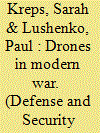

|
|
|
| 3 |
ID:
190870
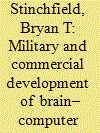

|
|
|
|
|
| Summary/Abstract |
Brain-computer interfaces (BCIs) are an emerging dual-use technology that will affect international security in ways similar to other dual-use technologies such as artificial intelligence, autonomous weapons, and cyber tools and tactics. In this paper, I use open sources and network analyses to reveal the structure of the BCI research and development industry, which indicates that BCIs will soon be operational, and the technology will diffuse across many sectors and regions. As a result, I argue that the unique qualities of BCIs will provide incentives to engage in conflict and disrupt international security; therefore, militaries in liberal democracies should strive to achieve and maintain BCI technological superiority over authoritarian regimes and violent non-state actors.
|
|
|
|
|
|
|
|
|
|
|
|
|
|
|
|
| 4 |
ID:
190869
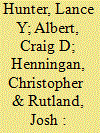

|
|
|
|
|
| Summary/Abstract |
A number of studies have considered the theoretical role that Artificial Intelligence (AI) may play in shaping the global balance of power in the future. While these studies are informative, we currently lack an understanding regarding the precise manner AI technologies are being applied and incorporated in militaries in major power states. Thus, in this study, we examine how AI technology is being applied in the militaries in the US, China, and Russia and analyse the implications for the future of AI, global military competition, and international security. We examine current research on the military application of AI technology in the US, China, and Russia and conduct expert interviews with leading AI experts in academia, think tanks, multinational technology companies, and the military to better understand how AI technology is being applied in the three major powers states and the implications for global security.
|
|
|
|
|
|
|
|
|
|
|
|
|
|
|
|
| 5 |
ID:
190873


|
|
|
| 6 |
ID:
190871
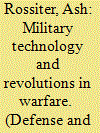

|
|
|
|
|
| Summary/Abstract |
The collection of essays in the special debate tackle the claim that drones deserve their acquired status as a revolutionary technology that has indelibly recast warfare. It is a debate embedded within a long-running and contentious, broader discussion about the role technology plays an independent variable affecting the character and perhaps the nature of war. How far can the introduction of a new technology really alter ways of fighting or radically impact battlefield outcomes? The complexity of the issue is reflected in the diversity of positions and approaches taken by the debaters. The purpose of these papers is not to arrive at a conclusion through a dialectic process; rather, readers are left to form their own views after weighing up the strengths of the arguments presented.
|
|
|
|
|
|
|
|
|
|
|
|
|
|
|
|
| 7 |
ID:
190874
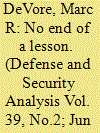

|
|
|
| 8 |
ID:
190875


|
|
|
| 9 |
ID:
190872


|
|
|
|
|
| Summary/Abstract |
Transformations, revolutions, evolutions, call them what you will. The simple fact is that the global proliferation of weaponised drones – known as the Second Drone Age – has altered the face of warfare in the 2020s. This is not to say that theoretical debates about what constitutes a true “revolution” in war are unimportant; more that the purpose of this article is to outline the clear ways in which armed drones have altered the practice of contemporary warfare. The broader academic debates will be left to those who wish to wage what Colin Gray called “protracted internecine combat” across the old “happy hunting ground” of “revolutionary” debates.Footnote1 Instead, by focusing on the context specific empirics of armed drone deployments, by both state and non-state actors, key characteristics of the Second Drone Age will be outlined, and the growing impact of drones in warfare documented.
|
|
|
|
|
|
|
|
|
|
|
|
|
|
|
|
| 10 |
ID:
190868


|
|
|
|
|
| Summary/Abstract |
In recent years State-sponsored assassination, reframed as “targeted killing” in the context of the war on terrorism, is undergoing a normalisation process due to the hybrid and asymmetrical threat of international terrorism. A more recent concern is the extension of the practice to the realm of inter-state relations, as exemplified by the assassination of the Iranian General Soleimani in January 2020. This paper argues that normative transformations in our understanding of concepts such as state sovereignty, alongside the persistence of inclusion/exclusion criteria in international relations, have facilitated the application of techniques and practices developed in response to non-state military threats in inter-state relations.
|
|
|
|
|
|
|
|
|
|
|
|
|
|
|
|
| 11 |
ID:
190867
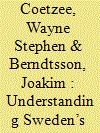

|
|
|
|
|
| Summary/Abstract |
This article aims to map out and analyse how Sweden’s security economy is shaped and sustained through security policies, political decisions, and personal connections amongst commercial and state elites. We treat the arms and security service industries as two sides of the same coin. In doing so, we address a shortcoming in the security literature that often analyses these two fields as separate areas of study with their own set of logic, research questions, theories, and methodologies. By bringing these two areas together, our study contributes to knowledge of the relationship between commercial defence and security actors and the state and a deeper understanding of Sweden’s security economy.
|
|
|
|
|
|
|
|
|
|
|
|
|
|
|
|
|
|
|
|
|